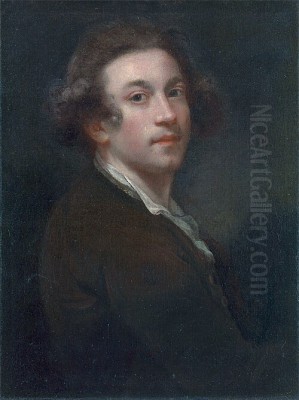
Sir Joshua Reynolds stands as a colossus in the history of British art. Dominating the London art scene for much of the latter half of the 18th century, he was not merely a painter but an architect of artistic taste, a theorist, an educator, and the founding President of the Royal Academy of Arts. Through his sophisticated portraiture, his advocacy for the "Grand Style," and his influential writings, Reynolds fundamentally shaped the course of British painting, elevating its status both at home and abroad. His life and work provide a fascinating window into the cultural, social, and intellectual world of Georgian England.
Early Life and Artistic Formation
Joshua Reynolds was born on July 16, 1723, in Plympton St Maurice, Devon, a small town in the southwest of England. His father, the Reverend Samuel Reynolds, was the master of the local grammar school and a fellow of Balliol College, Oxford. His mother, Theophila Potter, was the daughter of a clergyman. Joshua was one of several children in a family that valued learning and piety. Though his father initially entertained the idea of Joshua pursuing medicine, the boy's innate passion for drawing quickly became apparent. Early sketches and a demonstrable talent suggested a different path.
Recognizing his son's artistic inclinations, Samuel Reynolds arranged for Joshua to be apprenticed to the most fashionable London portrait painter of the day, Thomas Hudson, in 1740. Hudson, himself a Devon native, provided Reynolds with a solid, if somewhat conventional, grounding in the techniques of portraiture prevalent in England at the time, largely influenced by the earlier success of Sir Godfrey Kneller. Reynolds spent about three years in Hudson's studio, learning the practicalities of the trade, before a disagreement led to his early departure in 1743. He returned to Devon, setting up a practice in Plymouth Dock (now Devonport), where he painted local figures and naval officers.
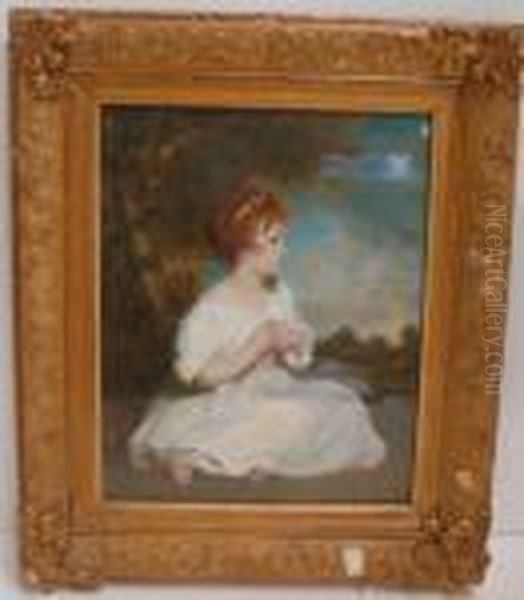
Even in these early years, Reynolds showed an ambition that transcended the standard face-painting of many contemporaries. He was intellectually curious, reading widely, particularly classical literature and art theory, such as Jonathan Richardson's "An Essay on the Theory of Painting." This intellectual grounding would prove crucial throughout his career, distinguishing him from artists focused solely on technical facility. His early works, while competent, hinted at a desire to imbue portraiture with greater dignity and psychological depth.
The Italian Journey and its Impact
A pivotal moment in Reynolds's development came in 1749. He seized the opportunity to travel aboard HMS Centurion, commanded by Commodore Augustus Keppel, who would become a lifelong friend and patron. This voyage took him to Lisbon, Cadiz, Algiers, and Minorca. From Minorca, he made his way to Italy, arriving in Rome in early 1750. This journey, extending over two years, was the transformative experience of his artistic life. Italy was the repository of the classical tradition and the masterpieces of the Renaissance and Baroque periods – the very foundations of the "Grand Style" he would later champion.
In Rome, Florence, Venice, Parma, and other artistic centres, Reynolds immersed himself in the study of the Old Masters. He filled notebooks with sketches and observations, analyzing the compositions of Raphael in the Vatican Stanze, the dramatic power of Michelangelo in the Sistine Chapel, the rich colours of the Venetian school (Titian, Tintoretto, Veronese), and the graceful elegance of Correggio in Parma. He wasn't merely copying; he was absorbing principles of composition, draughtsmanship, colour, and expression that would inform his own art. He sought to understand how these masters achieved their effects, aiming to synthesize their strengths into a new, elevated style suitable for modern Britain.
His time in Italy was not without personal cost. While visiting Minorca or possibly Rome, he contracted a severe cold or fever that resulted in significant and permanent hearing loss. For the rest of his life, he often relied on an ear trumpet, a detail sometimes subtly included in his self-portraits. Despite this disability, his Italian sojourn equipped him with an unparalleled visual education and a profound understanding of the European artistic tradition, setting him apart from contemporaries who lacked such extensive firsthand experience. He encountered fellow artists and connoisseurs, including the prominent Roman painter Pompeo Batoni, further broadening his horizons.
Rise to Prominence in London
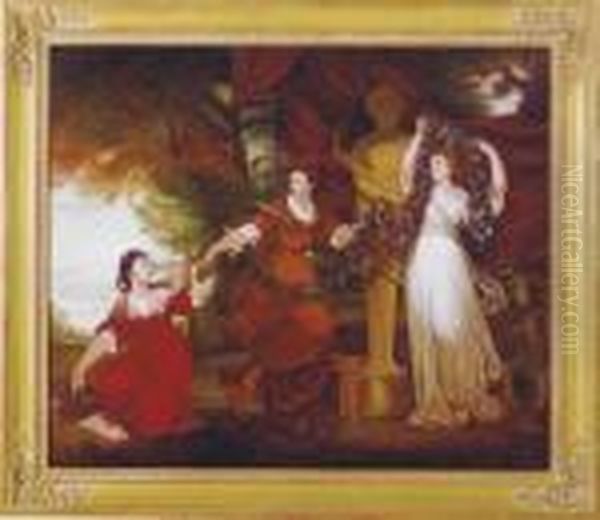
Returning to London in late 1752 or early 1753, Reynolds established a studio, first in St Martin's Lane and later, more grandly, in Great Newport Street and finally Leicester Fields (now Leicester Square). Armed with his Italian studies and a refined artistic vision, his impact was immediate and profound. His portraits offered a sophistication, intellectual weight, and connection to the revered art of the past that quickly eclipsed the more straightforward style of his former master, Thomas Hudson, and other established painters.
Reynolds rapidly attracted a prestigious clientele from the aristocracy, political circles, the military, and the burgeoning intellectual and cultural elite. His studio became a hub of fashionable society. He developed an efficient studio practice, employing assistants like Giuseppe Marchi and Peter Toms to help with drapery, backgrounds, and copies, allowing him to maintain a prolific output. His pricing was high, reflecting his status, but commissions flooded in. He cultivated an image of the artist as a gentleman and intellectual, moving comfortably in high society.
His deafness did not impede his social success. He was a founding member of "The Club" (later known as the Literary Club) in 1764, a circle of the leading intellectual lights of the age, including Dr. Samuel Johnson, the writer Oliver Goldsmith, the philosopher and statesman Edmund Burke, and the actor David Garrick. These friendships enriched his intellectual life and provided him with prestigious sitters. His portraits of these figures are among his most insightful and historically significant works. He engaged in rivalries, notably with the Scottish painter Allan Ramsay, who initially enjoyed royal favour, and more significantly with Thomas Gainsborough, whose fluid, naturalistic style offered a distinct alternative to Reynolds's classicism.
The Grand Style Defined
Central to Reynolds's artistic philosophy and practice was the concept of the "Grand Style" (or 'Great Style'). This was not merely about painting large pictures, but about elevating the subject matter, particularly portraiture, by imbuing it with the dignity, idealism, and universal significance associated with history painting – traditionally considered the highest genre of art. Reynolds believed that the artist should not simply copy nature slavishly but should idealize it, filtering out the accidental and imperfect to reveal a more profound or noble truth.

The Grand Style drew heavily on Reynolds's study of the Old Masters. He consciously borrowed poses, compositional structures, lighting effects, and even colour palettes from artists like Titian, Rubens, Van Dyck, and Rembrandt, as well as the masters of the High Renaissance like Raphael and Michelangelo. By referencing these revered figures, he lent his sitters an air of classical nobility or historical importance. A naval commander might be posed like a Roman emperor (as in Commodore Keppel), or a society lady might be depicted with allegorical figures or in classical drapery, transforming a simple likeness into a statement about virtue, beauty, or social role.
Key elements included generalized forms rather than minute detail, noble expressions, harmonious compositions, rich colour, and often dramatic use of light and shadow (chiaroscuro), particularly influenced by Rembrandt. Works like Sarah Siddons as the Tragic Muse, where the actress is enthroned between allegorical figures reminiscent of Michelangelo's Sibyls, exemplify the Grand Style's ambition to fuse portraiture with the intellectual weight of history painting. This approach aimed to appeal not just to the eye but also to the mind, engaging the viewer with classical and historical allusions.
Founding and Leading the Royal Academy
By the 1760s, London's art world, though vibrant, lacked a central institution to promote British art, provide structured training, and organize regular exhibitions. Artists like William Hogarth had earlier lamented the lack of national support. Reynolds, along with the architect Sir William Chambers and the American-born painter Benjamin West, was instrumental in petitioning King George III for the establishment of a Royal Academy of Arts. Their efforts succeeded, and the Academy was founded by royal charter in December 1768.
Given his pre-eminence, intellectual standing, and social connections, Reynolds was the natural choice for President. He was elected unanimously by the founding members, a diverse group that included his rival Thomas Gainsborough, the Swiss-born Angelica Kauffman, and the English flower painter Mary Moser – notable as the only two female founders. In recognition of his role and status, Reynolds was knighted by the King in April 1769, becoming Sir Joshua Reynolds.
As President, Reynolds took his responsibilities seriously. He oversaw the Academy's administration, guided its educational program (the RA Schools), and played a key role in organizing the prestigious Annual Exhibitions, which quickly became major events in London's social calendar. His leadership aimed to establish a professional standard for British artists, foster a national school of art grounded in the European tradition, and enhance the social status of the artist from mere craftsman to respected professional and intellectual. His presidency, which lasted until shortly before his death (with a brief interruption), was crucial in shaping the Academy's identity and influence.
The Discourses on Art
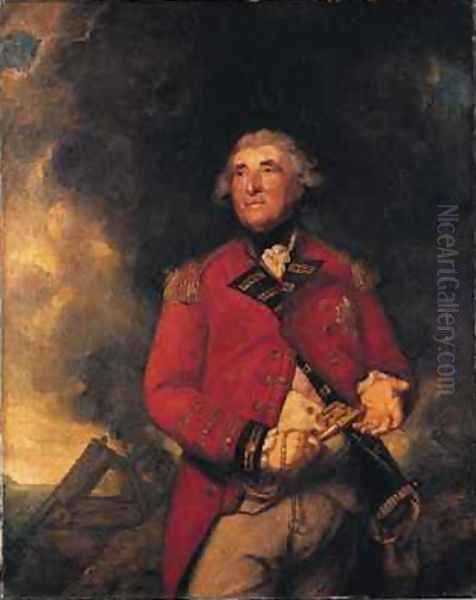
Perhaps Reynolds's most enduring intellectual contribution was the series of fifteen lectures, known as the Discourses on Art, delivered to the students and members of the Royal Academy between 1769 and 1790. Published individually and later collected, these Discourses represent the most significant body of art theory written by an English artist in the 18th century. They articulated Reynolds's artistic philosophy, outlined the principles of the Grand Style, and offered guidance to aspiring artists.
In the Discourses, Reynolds laid out a clear hierarchy of artistic genres, placing History Painting – the depiction of noble themes from history, mythology, and scripture – at the apex, as it required the greatest intellectual and imaginative effort. Portraiture, landscape, and genre painting were ranked lower, though Reynolds argued that even these could be elevated by adopting the principles of the Grand Style. He stressed the paramount importance of studying the Old Masters, particularly those of the Roman, Florentine, and Bolognese schools (like the Carracci), urging students to learn the established rules of art before attempting innovation.
He advocated for an art based on generalized, ideal beauty rather than the slavish imitation of individual peculiarities ("minute neatness"). The artist's goal was to capture the universal and permanent aspects of nature. However, Reynolds was not entirely rigid; he acknowledged the role of genius and innate sensibility, recognizing a "grace beyond the reach of art" that could not be taught solely through rules. The Discourses, while reflecting the neoclassical taste of their time, provided a coherent framework for art education and criticism in Britain for generations, influencing figures from J.M.W. Turner, who attended the RA schools, to later critics. They stand as a testament to Reynolds's belief in the intellectual dignity of the visual arts.
Masterpieces and Signature Works
Reynolds's output was vast, estimated at over 2,000 and possibly closer to 3,000 paintings, primarily portraits. Among these are numerous masterpieces that showcase his skill and artistic vision. His portrait of Commodore Augustus Keppel (1752-53), painted shortly after his return from Italy, established his reputation with its dynamic pose derived from the Apollo Belvedere and its dramatic coastal setting. Nelly O'Brien (c. 1760-62) demonstrates his mastery of light, influenced by Rembrandt, capturing a fleeting moment with remarkable sensitivity.
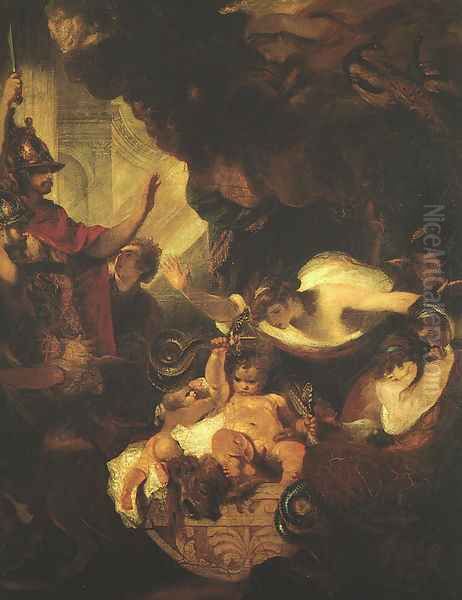
His portraits of children, such as The Age of Innocence (c. 1788), were immensely popular, displaying a tenderness and charm that appealed to the growing cult of sensibility. Group portraits like Three Ladies Adorning a Term of Hymen (1773) transformed society portraiture into complex allegorical compositions akin to history painting. His depiction of Georgiana, Duchess of Devonshire, and her Daughter (1784-86) combines aristocratic elegance with maternal affection. The powerful portrait of Lord Heathfield (1787), the heroic defender of Gibraltar, holding the key to the fortress against a smoky backdrop, is a quintessential example of the Grand Style applied to military portraiture.
Reynolds also tackled historical and mythological subjects, though less frequently than portraits. The Infant Hercules Strangling the Serpents (1785-88), a large and ambitious commission for Empress Catherine the Great of Russia, demonstrates his commitment to history painting, though critics debated its success. The Nativity was another significant religious work. Technically, Reynolds was known for his rich colour and bold brushwork, particularly in the rendering of faces. However, his experimental use of pigments and mediums, seeking the effects of Old Masters like Titian, sometimes led to unfortunate consequences, with some paintings fading, cracking, or darkening over time – a flaw noted even by his contemporaries.
Relationships and Rivalries
Reynolds's life was interwoven with connections to the leading figures of his time. His membership in The Club placed him at the heart of London's intellectual life, fostering close friendships with Samuel Johnson, whose portrait he painted several times, Edmund Burke, Oliver Goldsmith, and others. These relationships provided mutual intellectual stimulation and social standing.
Within the art world, his relationship with Thomas Gainsborough was complex. They were the two giants of 18th-century British painting, admired rivals whose styles represented different poles – Reynolds's classicism versus Gainsborough's rococo naturalism and landscape sensibility. While there was professional respect, there was also distance; Gainsborough was less involved in the Academy's politics. Gainsborough's supposed deathbed words, "We are all going to heaven, and Van Dyck is of the company," perhaps reflect their shared admiration for the Flemish master.
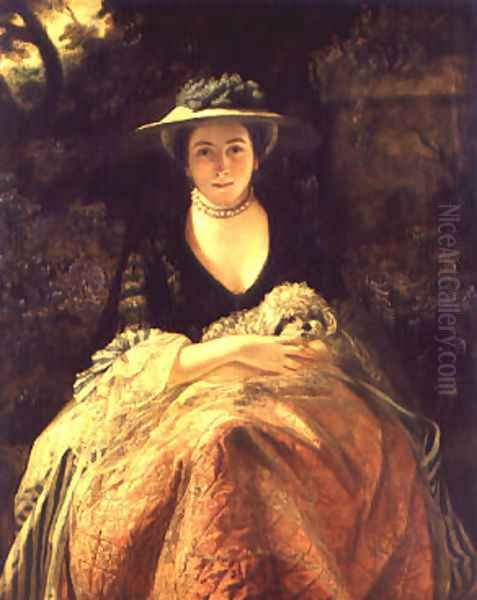
Reynolds supported younger artists like James Northcote and Thomas Lawrence, who would become his successor as the leading portraitist and the second President of the RA. He had more difficult relationships with others, such as the ambitious and volatile history painter James Barry, whose criticisms of the Academy led to his expulsion. He painted fellow RA founders Angelica Kauffman and Benjamin West. He also competed for commissions with George Romney, another highly popular portrait painter in London during the later decades of his career. His knowledge and appreciation extended to earlier masters like Rembrandt and Van Dyck, whose influence is palpable in his work, and he engaged critically with the legacy of William Hogarth, acknowledging his talent while critiquing his perceived lack of elevation.
Later Years and Challenges
The 1780s brought increasing challenges for Reynolds. His eyesight began to fail significantly around 1789, possibly due to cataracts or other conditions, forcing him to largely give up painting. This loss was a severe blow to an artist whose life revolved around visual perception. His lifelong deafness also continued to be a factor he managed with resilience.
He also faced difficulties within the Royal Academy. A dispute arose in 1790 over the election of a new Professor of Perspective, with Reynolds favouring the Italian architect Joseph Bonomi the Elder. When the Academy members rejected his candidate, Reynolds felt his authority undermined and briefly resigned the Presidency in protest. Although persuaded to return by the King and the Academy members, the incident revealed underlying tensions and perhaps marked a shift in the institution he had led for over two decades.
Despite these challenges, he remained a revered figure. He delivered his fifteenth and final Discourse in December 1790, concluding with a moving tribute to his ultimate artistic hero, Michelangelo. His final years were spent in declining health, cared for by his niece, Mary Palmer (later Countess of Inchiquin), who had long managed his household.
Death and Burial
Sir Joshua Reynolds died at his house in Leicester Fields, London, on the evening of February 23, 1792, at the age of 68. His death was widely mourned as the passing of a national figure. His body lay in state at the Royal Academy's premises in Somerset House before a grand funeral procession, attended by nobility, statesmen, artists, and writers.
He was buried in the crypt of St Paul's Cathedral, a place of national honour, near the tomb of Sir Christopher Wren, the cathedral's architect. The pallbearers included dukes, marquesses, and earls, signifying the high esteem in which he was held and the elevated status he had achieved for himself and his profession. Edmund Burke, his long-time friend, wrote a moving obituary praising his art, intellect, and character, calling him "the first Englishman who added the praise of the elegant arts to the other glories of his country."
Legacy and Enduring Influence
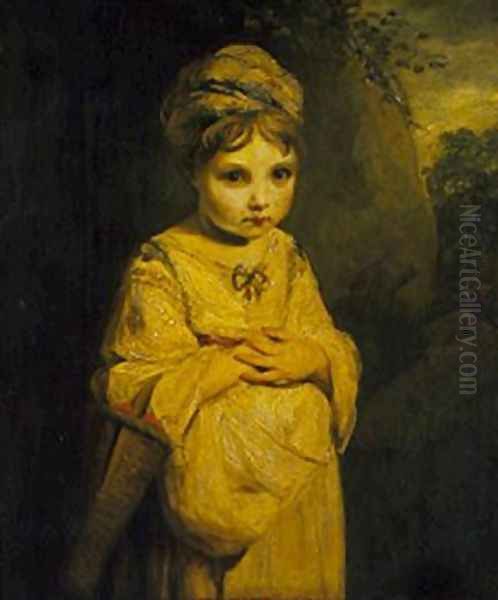
Sir Joshua Reynolds's legacy is immense and multifaceted. He dominated British art for nearly four decades, setting the standard for portraiture and shaping artistic taste. Through the Royal Academy and his Discourses, he established a theoretical and educational framework for British art that emphasized professionalism, intellectual rigour, and a connection to the European Grand Tradition. He undeniably raised the social standing of artists in Britain.
His Grand Style, while rooted in the neoclassical ideals of his time, profoundly influenced subsequent generations of portrait painters, notably Sir Thomas Lawrence and Sir Henry Raeburn, even as Romanticism began to offer alternative artistic paths (William Blake, for instance, famously annotated his copy of the Discourses with critical remarks). His technical innovations, particularly in colour and handling, were studied and adapted, even while the instability of some of his materials served as a cautionary tale.
Reynolds effectively created a visual identity for the British elite of the Georgian era. His portraits remain invaluable historical documents, capturing the likenesses and aspirations of the men and women who shaped 18th-century Britain. More than just a painter, Sir Joshua Reynolds was a pivotal figure who guided British art towards greater sophistication, ambition, and international recognition, securing his place as one of the most important artists in British history. His influence permeated the very fabric of British art education and practice well into the 19th century and beyond.